By Christopher Miskimon
In November 1942, the Anglo-American invasion of North Africa, Operation Torch, caused a short but intense conflict with French forces loyal to the Vichy regime in power on the European mainland. The Allies sought to finish the Axis presence not only in Vichy-controlled areas but also to eliminate the Italian-German forces to the east in Libya. The British Eighth Army, fresh from victory at El Alamein, was steadily pushing those forces westward. Taking control of the entire North African coastline would cement the Allied position and make follow-on operations in the Mediterranean Theater possible.
It was hoped the French in the area would quickly come over to the Allied cause rather than side with the collaborationist Vichy government based in occupied France. Much intelligence work and political maneuvering occurred behind the scenes to ensure just such an outcome. Still, it was by no means certain which way the French troops would go when American and British soldiers came ashore. In particular, the French were still angry over the British attack on their navy at Mers-el-Kebir in July 1940. The British, afraid the French ships would be surrendered to the Germans as part of the armistice, had attacked a French force when it refused an ultimatum to either join the British or be interned in neutral territory. The British also supported or conducted attacks on French colonial bases in other parts of Africa. Despite the presence of Free French forces allied to the British, it was unclear whether the French in North Africa would be willing to essentially switch sides and march alongside the British and Americans. In light of this uncertainty, the invasion force had to be prepared to fight.
Part of these preparations included seizing Algiers Harbor intact. The invading armies required functioning ports to remain well-supplied with fuel, ammunition, food, and all the necessities of modern warfare. If the French stayed loyal to Vichy and wrecked the port facilities, it would render the Allied logistical effort much more difficult, delaying the advance eastward against the Axis. To this end, a risky plan to seize the harbor by coup-de-main was proposed. It would use a battalion of American soldiers and a pair of British destroyers in a joint operation code-named Terminal.
Operations Terminal and Reservist
Terminal was one of a pair of operations designed to seize intact harbors. The other, named Reservist, was a similar plan to capture the port facilities at Oran. Both were the ideas of British planners based on a prior, successful mission in the same vein. In May 1942, British forces invaded Madagascar, another Vichy French territory, to keep its maritime facilities out of Axis hands. During the assault on the port of Diego Suarez, a British destroyer rushed through the French defenses and landed a force of Royal Marines, who caused such havoc in the town the French defense was quickly defeated. The British hoped to repeat their success with such daring attacks on the North African ports at Oran and Algiers, both necessary to Allied objectives.
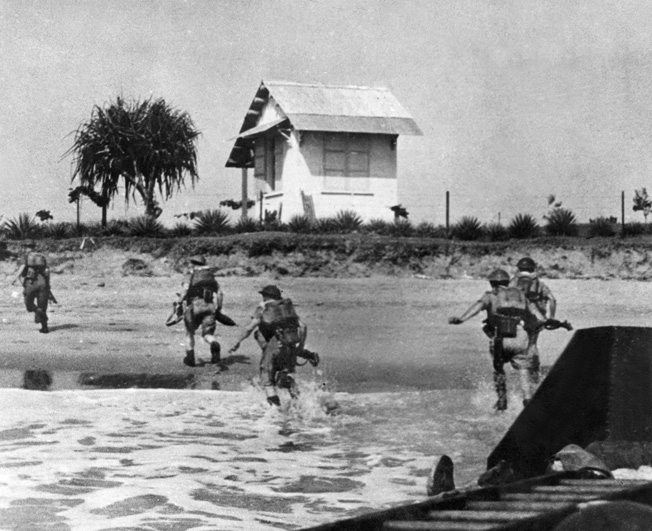
Both plans were essentially the same. A pair of British naval vessels would carry a force of American troops into the harbor. Upon landing the troops would spread through the port, capturing key facilities such as fuel depots and docks for unloading supplies. They would hold their positions until the main landing forces fought their way into the city and linked with them. If things went well, it was hoped the local French might even surrender to the American soldiers without a shot fired.
Many of those involved held strong reservations about the success of these plans. There were doubts the French would give up so easily, especially since they had fought fiercely at other places, such as Madagascar and Dakar. Also, many questioned how the French would know whose troops were coming ashore in the dark or whether they would trust what they saw even with large American flags flying prominently.
British Prime Minister Winston Churchill himself said, “In the night, all cats are grey,” in reference to the idea. Some thought the idea bold and aggressive, a worthy notion. Others considered it tantamount to suicide for the assigned men. Even so, after deliberation, American General Dwight D. Eisenhower, senior Allied commander in the Mediterranean, approved the plan despite the varied opinions about it. For Operation Torch to succeed, the Allies needed those port facilities intact, and he deemed the risk, although high, worth the potential result.
“He Strives in Difficulties”
Algiers was the target of Operation Torch’s Eastern Task Force. The assault force for the actual invasion was composed of the British 11th Infantry Brigade along with the U.S. 39th and 168th Regimental Combat Teams from the 9th and 34th Infantry Divisions, respectively. Each unit was assigned its own beach to land on with follow-on missions to seize vital objectives and move into the city proper. Two battalion-sized groups of British Commandos were also assigned to go ashore and capture vital coastal gun emplacements and forts.
Many of the British troops would wear American uniforms as it was thought the local inhabitants would be more favorably inclined toward Americans. Overall command of the Eastern Task Force fell to British Lt. Gen. Kenneth Anderson. However, the amphibious phase of the operation would be led by American Maj. Gen. Charles Ryder, again an attempt to soften French reaction to the landings.
Two World War I-era destroyers were selected for the Terminal operation. The first was HMS Malcolm, commissioned in 1919. Armed with a pair of 4.7-inch guns, a suite of lighter antiaircraft guns, and torpedoes, Malcolm was just over 332 feet long and displaced 1,530 tons. Her Latin motto, In ardua tendit, “He strives in difficulties,” would prove apt. The second ship, HMS Broke, was begun in 1918 but not completed until 1925. Displacing 1,480 tons and 329 feet long, Broke had a heavier main armament of five 4.7-inch guns. There was not enough room in quarters aboard the two ships for hundreds of infantrymen, so most would have to stay on deck.
To provide a modicum of protection during the assault, both destroyers had sheets of iron a quarter-inch thick welded all the way around the deck to form a makeshift shield against small-arms fire. The entrance to Algiers Harbor was protected by a steel boom, so both ships had their bows reinforced to allow them to break through it.
The Minnesotans from the 34th Division
The unit selected to go ashore was the 3rd Battalion, 135th Infantry Regiment, a standard U.S. infantry battalion of the 34th Division. The entire division was training in the United Kingdom. Though the unit had no specialized training for such a mission, it was chosen and ordered to move from its training site in Northern Ireland to a camp near Belfast. Since the choice had been a last-minute affair, counterintelligence agents spread rumors through the rest of the regiment that 3/135th was sent on maneuvers in the Sperrin Mountains.
The battalion was a unit of the Minnesota National Guard, activated in 1940 as part of the 34th Division, a “pure” National Guard formation composed of units from several states brought together. At this early stage of the war, most of a National Guard regiment’s troops were still from their home state. Only after the infantry took casualties in combat did such units absorb replacements from across the United States. For its first mission 3/135th was a Minnesota battalion. Many of its soldiers sported Nordic surnames, and the regiment had a tradition going back to the Battle of Gettysburg, where it earned its motto, “To the last man.” Third Battalion had also earned the sobriquet “The Singing Third”; its men had a wide range of barracks songs, some of them considered rather bawdy.
The commander, Lt. Col. Edwin T. Swenson, a native of Stillwater, was described by one subordinate as dynamic and aggressive. Reportedly possessed of a generous nature and a quick sense of humor, Swenson also had a tough side; before the war he had been assistant warden at the Minnesota State Penitentiary. After arriving in Britain he had bragged that his battalion’s top sergeant had to be able to best him in a fight. He was also known for his excellence at swearing.
With little time to prepare for the new assignment, the battalion threw itself into intense training including some specialized techniques for assaulting a harbor, though neither officers nor men knew where they were training to go. Around 40 British naval personnel joined the battalion; once ashore they would help form joint boarding parties to seize ships docked in the harbor. To help maintain the illusion of English noninvolvement, they were also issued American uniforms.
Every day, the battalion would be trucked to Belfast Harbor for training. Just before training ended, the entire battalion went to the harbor and practiced loading and unloading from the Malcolm and the Broke. A small detachment from M Company remained on the destroyers at the end of the night. Finally, on the morning of October 26, the rest of 3/135th, 634 soldiers, embarked on the cruiser HMS Sheffield for their journey to the Mediterranean. Luckily for the ship and passengers, the trip was uneventful and the weather good. Two nights later, Sheffield joined a convoy headed for the shores of North Africa via Gibraltar.
Concern Over the French Guns
The next night, October 29, the Americans were briefed by Captain Henry Fancourt of the Royal Navy. A veteran of Jutland, Fancourt would take command of the Malcolm and Broke for the mission. It was the first time the U.S. officers were given detailed information about what was expected of them. After they had gathered in Sheffield’s wardroom, each was given a detailed map of Algiers Harbor, though none knew it was Algiers; all reference to the city’s name had been removed. Fancourt told them the combined Anglo-American group had been designated Terminal Force. After Sheffield passed through Gibraltar, the U.S. troops would transfer to the destroyers for the rest of the voyage.
Lieutenant Colonel Swenson was aware of the general plan and continued the briefing. After leaving Gibraltar, Sheffield would speed ahead of the convoy to rendezvous with the destroyers. Company K along with two platoons of Company I would go aboard the Malcolm, while Company L and the rest of Company I would transfer to the Broke. Those soldiers from Company M (the battalion’s heavy weapons company) not already aboard the destroyers would be divided among the two ships along with a party of medical troops attached for the mission.
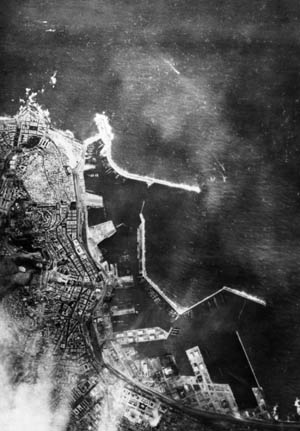
some of the difficulties faced by the Allied
warships and troops that undertook
Operation Terminal. The harbor was defended by several strongpoints with heavy artillery that took its toll on the invaders.
With the transfer complete, Terminal Force would proceed to the unnamed French city and take part in the landings. The destroyers would break through the harbor’s boom, Broke in the lead followed by Malcolm 15 minutes later. Once in the harbor they would land the American soldiers, who would seize the harbor installations to prevent sabotage.
The officers studied their maps closely. The city was located along the shoreline on level ground that soon turned into hills and ridges to the west that overlooked the harbor. That harbor was crescent shaped and opened to the east. There were a number of concrete jetties or breakwaters extending from the shore to protect the inner harbor. The steel boom was strung between two of them. A number of coastal gun emplacements surrounded the area and seemed able to place fire on the harbor itself. This concerned a number of the American officers until Captain Fancourt told them British Commandos were assigned to capture the emplacements, which in any event probably could not depress their guns far enough to effectively fire on the port.
The Americans were also concerned about the number of French gun emplacements. This concern was abated when the Americans, totally ignorant of how to interpret aerial photographs, realized some of the positions they had identified as gun emplacements were actually latrines. The total area the battalion was expected to occupy ran some 3,000 yards from the port offices in the north to a jetty called the Brise Lames Est, to which one end of the boom was attached. Terminal Force would make its assault two hours after the main element of the Eastern Task Force began its landing. It was hoped this would give the French time to redeploy troops to meet the other landings and make taking the harbor easier.
Three Variations of the Plan
The Americans came up with three variations of their plan to capture the port. Plan A assumed both destroyers were able to land their troops and each platoon was given specific objectives, such as the electric power station, oil depot, and seaplane base. The mixed Anglo-American boarding parties would take over any ships docked in the harbor. Plans B and C assumed one or the other destroyer did not make it and the troops on the ship that succeeded would have to assume the entire mission. A fourth plan covered the complete failure of the mission, in which case the destroyers would sound three blasts from their sirens to recall all the landed troops for withdrawal. The naval vessels offshore, including Sheffield, would be ready to give fire support with their heavy guns.
After a brief stop at Gibraltar, the Sheffield sped on its way to rendezvous with the Malcolm and Broke. Once clear of its final stop, the need for secrecy abated, and the Americans learned they were going to Algiers. The plan, along with additional copies of the map, were given to all the noncommissioned officers. On the afternoon of November 6 (some sources say November 7), the three British ships met for the transfer of personnel. Malcolm came alongside first at 1630 hours, and those Americans assigned to her went aboard without difficulty. An hour later the Broke did the same. Swenson went aboard the Broke with Captain Fancourt while the battalion’s executive officer, Captain William Snellman, went aboard Malcolm.
A Blind Charge into the Harbor
With all the Americans aboard their respective ships, Terminal Force set out for Algiers and the rest of the Eastern Task Force. There was no moon that night, and clouds blocked out the starlight. Since there was not enough room below to berth the soldiers, most had to stay on the main deck with little room to move around. Luckily, the weather was warm and the men experienced little discomfort. Swenson had his men lie down early in the evening of November 7; they would awake at midnight and make ready to go ashore.
Midnight arrived and with it November 8, 1942, the day of the landings. The troops were roused and told to prepare themselves. With everyone already gathered, only an hour passed before one and all, U.S. Army and Royal Navy alike, were ready. Tension was heavy in the air as the men awaited the order to proceed. Captain Fancourt received that order at 0220 hours. The landings around Algiers were a success; Terminal Force was to carry out its mission.
Malcolm and Broke sailed east through the waters off the North African coast for another hour before the lights of the city of Algiers shone like a beacon just a few hundred yards off the destroyer’s starboard side. Lieutenant Leslie Bailey, a platoon leader in 3/135th, recalled what he saw that night: “Upon closer approach we could see at irregular intervals the orange flashes of artillery fire to the rear of Algiers but not from the batteries within the city limits. Suddenly all lights were extinguished, leaving only the dim outline of the higher buildings visible through the dusky gloom.”
Whether the French had spotted Terminal Force or whether they had simply taken a long time to black out the city, the Allied troops could not be sure. They had their answer moments later when searchlights from the harbor defenses snapped on and began questing through the darkness. The destroyers came up to full speed for their runs at the boom. For a time they stayed hidden in the night, but even though the beams of light did not touch them both ships’ crews were partly blinded by the lights. This threw them off course, outside the eastern jetty the boom was attached to. Both ships had to come around for another try, Broke in the lead.
One Destroyer Down
As they turned sharply to line up on the boom, the searchlights finally found Malcolm, which came under fire from the Batterie des Arcades, situated south of Algiers on a hill overlooking the city. The destroyers began making smoke to obscure themselves from the French gunners, but this only made the boom harder to find. Broke missed on her second attempt and turned again for another run. By now, the French had found her too and she began taking fire from shore batteries to the north and south.
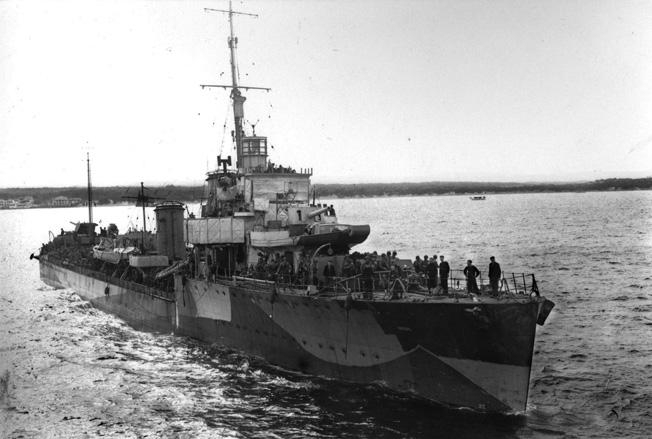
Malcolm came around as well, and Fancourt signaled her from the Broke to get into the harbor if she could. Again Malcolm missed the boom and heeled off to come around. As she turned, the French found the range and Batterie des Arcades hit her several times. A fire started amidships, revealing Malcolm to every gunner ashore. One of the incoming rounds hit the ship’s smokestack; shrapnel flew everywhere, slashing into the helpless infantry crouching upon the deck below. A second shell went through the destroyer’s center hatch and exploded below decks, disabling three of the ship’s four engines. Simultaneously, a large supply of American mortar ammunition, stored amidships, was set afire by the explosions. The ammunition was packed in tarred pasteboard boxes, which now burned brightly. Malcolm was an easy target for French guns.
Realizing the danger the fire posed, American 2nd Lt. William Muir took action and likely saved the ship. He ran to the burning ammunition boxes, heedless of the danger, and began throwing them overboard. Other soldiers saw this selfless act and were inspired to join him. Together they flung all the burning ammunition overboard into the dark waters of the harbor, extinguishing the fire that threatened not only to further damage the ship but exposed her to her foes. Still, the destroyer was badly damaged and her captain decided to withdraw. Listing badly and her speed reduced to four knots, Malcolm slowly made her way out to sea where she took up position outside the harbor mouth.
Broke in the Harbor
With half the force now out of action, Captain Fancourt decided to continue the mission with just the Broke. A third attempt on the boom was thwarted by the angry fire of the shore batteries, now able to concentrate on the single remaining ship. Determined, Fancourt ordered another pass. The fourth try was a success, and Broke sliced through the boom at high speed.
Lieutenant Bailey recalled there was almost no sensation they had even struck the boom. Now inside the harbor, the destroyer made for the Grande Mole dock in the center of the port. As they approached, however, it became clear that the dock was already jammed with ships, so the attacking ship was diverted to a nearby quay just to the south, the Quai de Falaise. HMS Broke pulled alongside the quay and prepared to disembark her American troops.
Before the Americans could get ashore, several of the ships tied up at the Grande Mole began pouring machine-gun fire at the Broke. More fire came from warehouses near the oil depot just west of the ship’s berth on the Quai de Falaise. Several British sailors were wounded before their comrades manning the ship’s 20mm Oerlikon cannon returned fire, hosing the enemy with cannon shells. Within moments the French weapons were silenced.
Parley with the Vichy
With the way now clear, the American infantry dashed off the Broke and began seizing their nearby objectives. Swenson shouted to his men to “light out like stripey-assed baboons up the wharf until you can get some cover, then fight like hell.”
Within minutes the entire area of the quay, the oil depot, and the power station were all in U.S. hands. It was now about 0520 hours. More objectives lay to the north, but it was not clear that the Americans ashore had the numbers to effectively occupy them. For the time being, they took up defensive positions around what they had already secured and attempted to gain intelligence about French intentions. Would the French fight or surrender? Sporadic machine-gun fire raked the streets and intersections around the U.S. positions, but it was incredibly inaccurate.
The next few hours passed without any major fighting. The GIs observed that the city smelled like a barroom; the locals had little gasoline and powered their vehicles with alcohol, leaving an odor hanging over the town. At 0800 hours, four Frenchmen, two civilians and two policemen, approached the American lines to parley. They were taken to Lt. Col. Swenson to confer.
The French wanted to arrange the surrender of the city to the Americans and asked for a representative to return with them to negotiate. It would have been welcome news, but at the same time one of the British officers from the boarding parties reported a meeting with a French Army officer. This Frenchman told the British officer the American force was surrounded and the local French troops had no intention of giving up the fight. It was a confusing situation.
Broke‘s Withdrawal
As Swenson pondered his next move, artillery fire began crashing around them from a French battery to the north. The Broke was struck by the third round, which passed completely through the ship’s bow. The destroyer moved slightly west to place the docks and buildings of the Grande Mole between the ship and the battery. More artillery roared in, blanketing the entire area between the American defenses and the British destroyer. The Batterie des Arcades to the south now zeroed in on Broke and after six ranging rounds hit her five times. One shell hit the destroyer in the sick bay, killing one of the ship’s doctors and blowing off the other’s arm. Self-administering a shot of morphine, the wounded doctor gave an American medic advice on how to perform several amputations before he passed out.
Broke was now the main target of the French batteries, which had apparently not been seized by the commandos and were indeed able to depress their guns to engage targets in the harbor. Fancourt decided he had to withdraw the destroyer before she was sunk. Accordingly, he sent the withdrawal signal of three blasts from the ship’s siren at 0930 hours.
Swenson heard the signal but decided to stay. He reasoned the incoming artillery would wreak havoc on his soldiers as they fell back to the Broke and force the destroyer to remain a still target longer. The main landing forces had been ashore almost 10 hours and should be arriving in Algiers soon. He was certain 3/135th could hold out a few more hours. Sixty of the Americans did get aboard the Broke and left with her.
Since the rest of the Americans were determined to stay, Fancourt immediately got Broke underway. The wounded destroyer pulled away from the dock and made for the open sea, French shells falling all around her. One wounded American, Pfc. Harold Cullum, had crawled out to the destroyer but could not get aboard before it left. He lay on the dock’s edge, pulled out his canteen and some sulfa tablets, and watched the ship leave. More of the incoming fire struck, and soon the hapless warship was disabled.
Another destroyer risked coming in and soon took the Broke under tow, pulling her out of the harbor to the open Mediterranean amid a flurry of falling shells. The destroyer had been hit some 22 times; water rushed in through shellholes far faster than it could be pumped out. Broke was doomed. Captain Fancourt ordered the ship abandoned, and the crew transferred to the towing ship. Some time later the valiant little destroyer slipped beneath the waves for good, taking with her 3/135th’s reserve ammunition and the soldiers’ personal effects and equipment.
End of Hostilities for 3/135th
Ashore, the American situation was deteriorating. The infantrymen had been busy fortifying their perimeter with shipping crates and hay bales stored in the nearby warehouses. Now they had an all around defense. At 1100 hours a half dozen Allied dive bombers arrived overhead and furiously bombed two of the French batteries to the north, knocking both out of commission. This was a break the Americans needed, as a French force was apparently gathering for an attack. The Americans sent a fusillade of small-arms fire at them. It worked, but the Americans were gradually running low on ammunition.
Casualties began to mount. Pfc. Melvin Lein, one of the attached medics, was told a wounded officer lay nearby. A French machine gun fired continuous bursts across the path Lein had to take to get to the casualty. Braving the heavy fire, the medic got to the man and rendered aid. As he returned to his assigned position the machine gun zeroed in, killing Lein. For his courage he was awarded a posthumous Distinguished Service Cross. A second DSC would be awarded to Staff Sergeant Robert Rooney. As he led his squad through an intersection under heavy machine-gun fire, one of his men, Private Lawrence Fonder, was hit. The young soldier fell to the ground completely exposed to the enemy fire. Despite the bullets snapping all around, Rooney ran back to Fonder and carried him out of danger.
At 1130 hours, the French decided to push again. This time a company of 10 Renault tanks took up positions all around the U.S. perimeter and deluged it with cannon and machine-gun fire. This started fires among the hay bales and detonated some of the dwindling supply of mortar shells. All the Americans possessed were a few antitank rifle grenades. They promptly used them but scored no hits. Afterward, the beleaguered Minnesotans grimly fixed bayonets and waited for the impending assault.
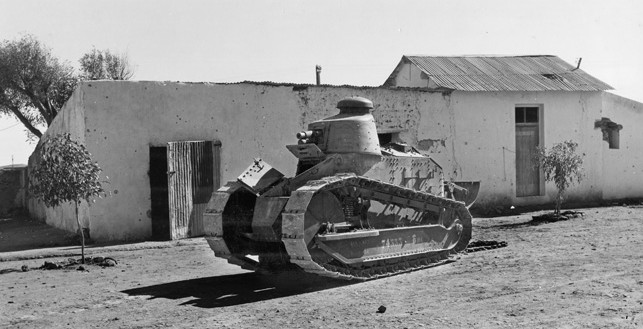
The overall situation had now turned against 3/135th. There was no sign the other landing forces were nearing the harbor. The French forts were still active except for those eliminated by air strikes, and there was no naval gunfire support from the Allied task force offshore. Swenson was reluctant to use his remaining mortars and machine guns for fear of hitting the French civilians he could see moving around nearby. The Americans had no more antitank weapons to fend off the Renaults, and with their backs to the sea there was nowhere to retreat. The commander with a gift for swearing decided there was no reason to extend the fighting and cause further casualties. At 1230 hours the Minnesotans surrendered to the French.
3/35th in Captivity
With fighting now over at the port, the Americans marched out of their positions into captivity. A company of French naval personnel and three companies of Senegalese colonial soldiers took custody of the U.S. troops, a dozen tanks and armored cars supporting them. Stretcher parties gathered all the wounded from both sides and carried them off for treatment. As they did so the Senegalese lined up the Americans in the street and proceeded to loot them of every watch, piece of jewelry, and wallet the Yanks were carrying. The theft incensed Lt. Col. Swenson, who immediately complained to the French officer commanding the group.
The Frenchman had a simple way to deal with it. He lined up a few of the Senegalese and announced he would shoot them in two minutes if the valuables were not given back. The rest of the Senegalese immediately relinquished the stolen property. Afterward, the U.S. enlisted men were marched away to a nearby barracks under guard. As they left a sniper fired a last shot at the unarmed Americans, killing Corporal Alvin Ronning.
A van arrived, and the American officers were loaded aboard. A short drive took them to the French naval headquarters at the north end of the port. There, a French Navy officer with the rank of commander put a .45-caliber pistol to Swenson’s stomach and demanded details of the Eastern Task Force landings, threatening to put them all in a dungeon if they did not cooperate. It was a tense and frightening moment, fortunately broken by the arrival of a French Navy captain who immediately took control of the situation and admonished his fellow Frenchmen to give full courtesy to the Americans. Whether this was from a true sense of courtesy or a realization that Allied forces were poised to take Algiers and would not react well to prisoner abuse is unknown, but afterward the U.S. officers were well treated and even ate at the officer’s mess.
As the fighting around Algiers gradually wound down, the courteous treatment of the French officers continued. Though a number of them made it clear they were opposed to the invasion and the Allies, others seemed to support the landings, likely realizing siding with the Anglo-Americans was the surest way to a free France. The latter group even gave the Americans updates on the progress on the landing forces as they closed on the city. Some of the French naval officers even complimented the Royal Navy crew of the Broke, saluting their skill and bravery at slicing through the boom under such heavy fire.
As 3/135th went to its temporary captivity, offshore the crew of the Malcolm tried to get back into the harbor but the warship was too severely damaged to complete the attempt. Most of the soldiers aboard were later transferred to an LST that put them ashore. By the time they reached Algiers, the fighting was over. Those who remained on the Malcolm were taken into the harbor aboard her on November 10, the same day their fellow Americans taken prisoner by the French were released.
Losing the Battle, Saving the Port
Though the mission ended in apparent failure, there was some victory to be pulled from the ordeal of Terminal Force. The French were so busy dealing with it they had no time to demolish the port, which sat largely intact despite the shelling by the French forts. These facilities would be of great use to the Allied armies in the months to come as they pushed east into Tunisia and the awaited confrontation with the Axis.
It came at a stiff cost, however. Casualties in 3/135th came to 15 dead and 33 wounded while the crews of the Malcolm and Broke lost another 25 killed and an equal number wounded. One estimate put French losses at 70 killed and 100 wounded. By comparison, however, it was worse for Reservist, the similar force assigned to assault Oran harbor. It failed utterly, suffering 90 percent casualties.
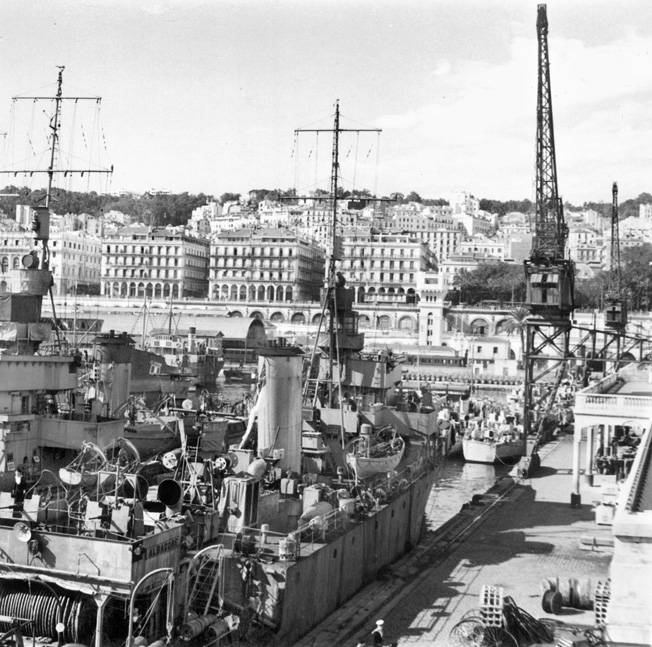
Lieutenant William Muir later received a letter from the Admiralty that he was to be mentioned in despatches for his gallantry in flinging the burning mortar ammunition overboard. He later earned a Silver Star for rallying his soldiers during a defensive battle in Tunisia. Promoted to captain, he died in Italy in October 1943, struck down by malaria and jaundice.
To honor the unit for its actions, the 3rd Battalion, 135th Infantry was appointed the Honor Guard for 34th Division formal functions and ceremonies. The 34th would go on to fight its way across Tunisia, Italy, and France, and into Germany, ending the war as part of the U.S. Seventh Army. It endured 500 days in combat, a total exceeded by only one other division in the U.S. Army; all this began with a single battalion and a desperate assault in Algiers.
Christopher Miskimon is a regular contributor to WWII History. He is an officer in the Colorado National Guard’s 157th Regiment.
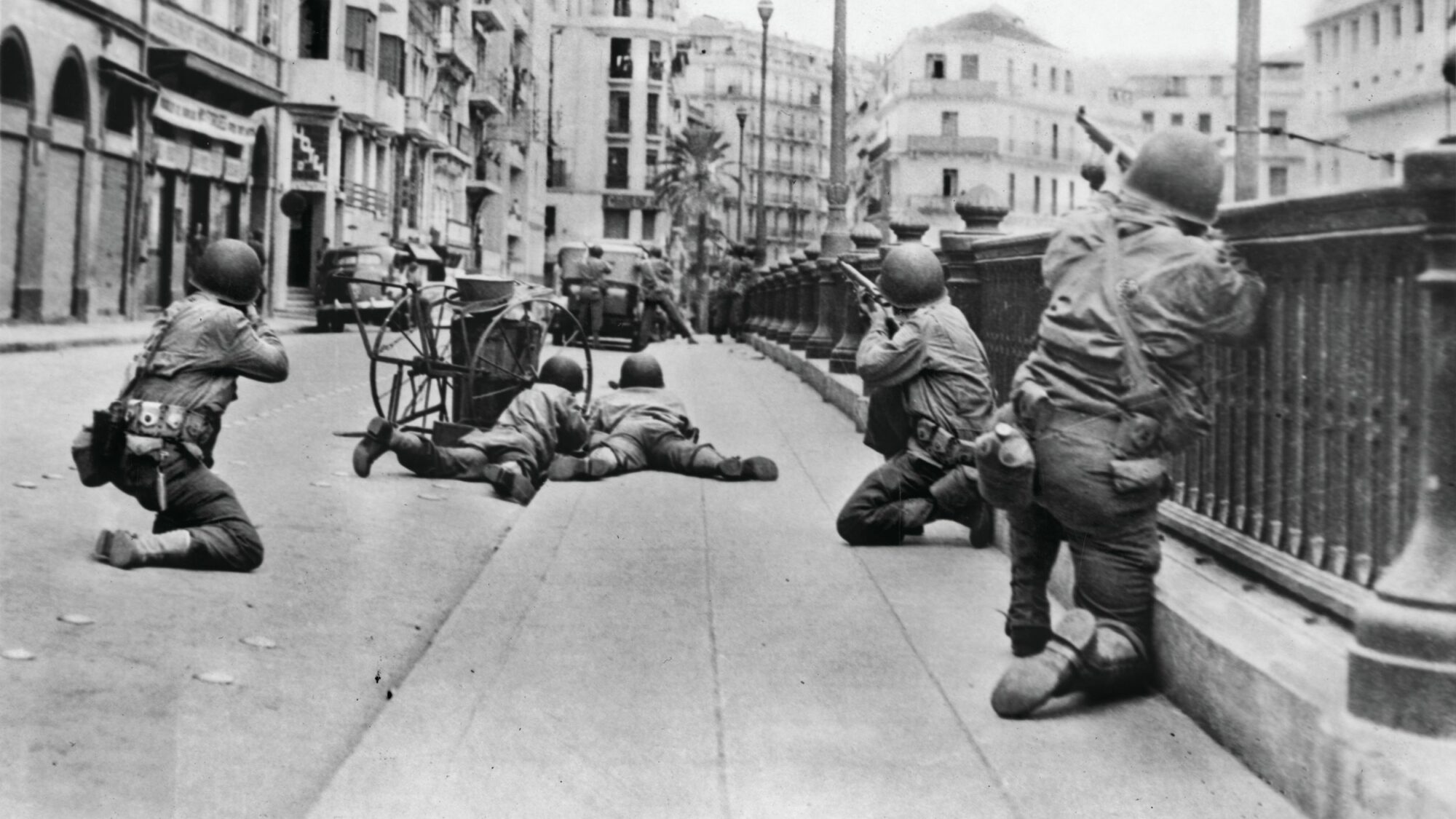
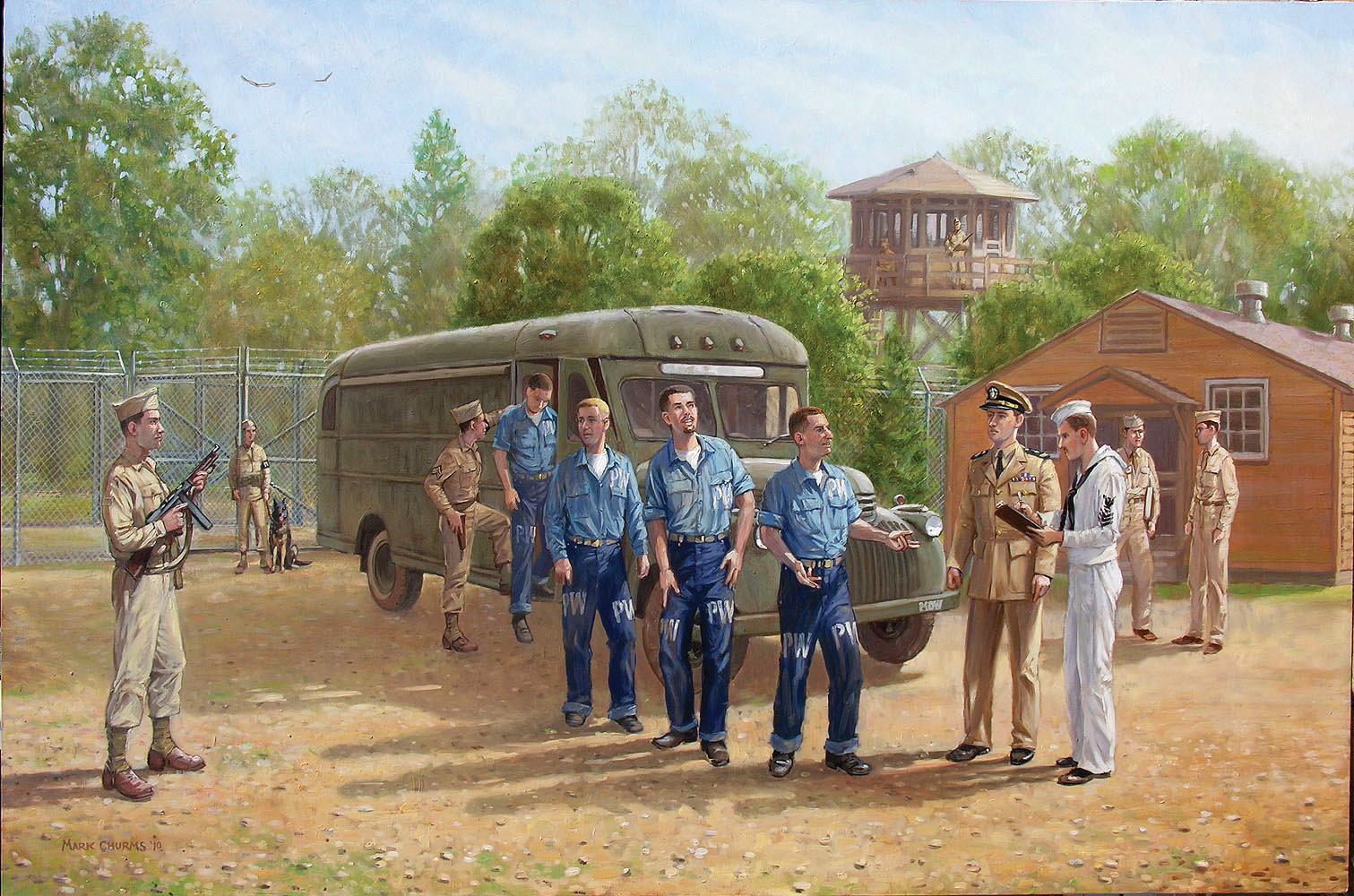
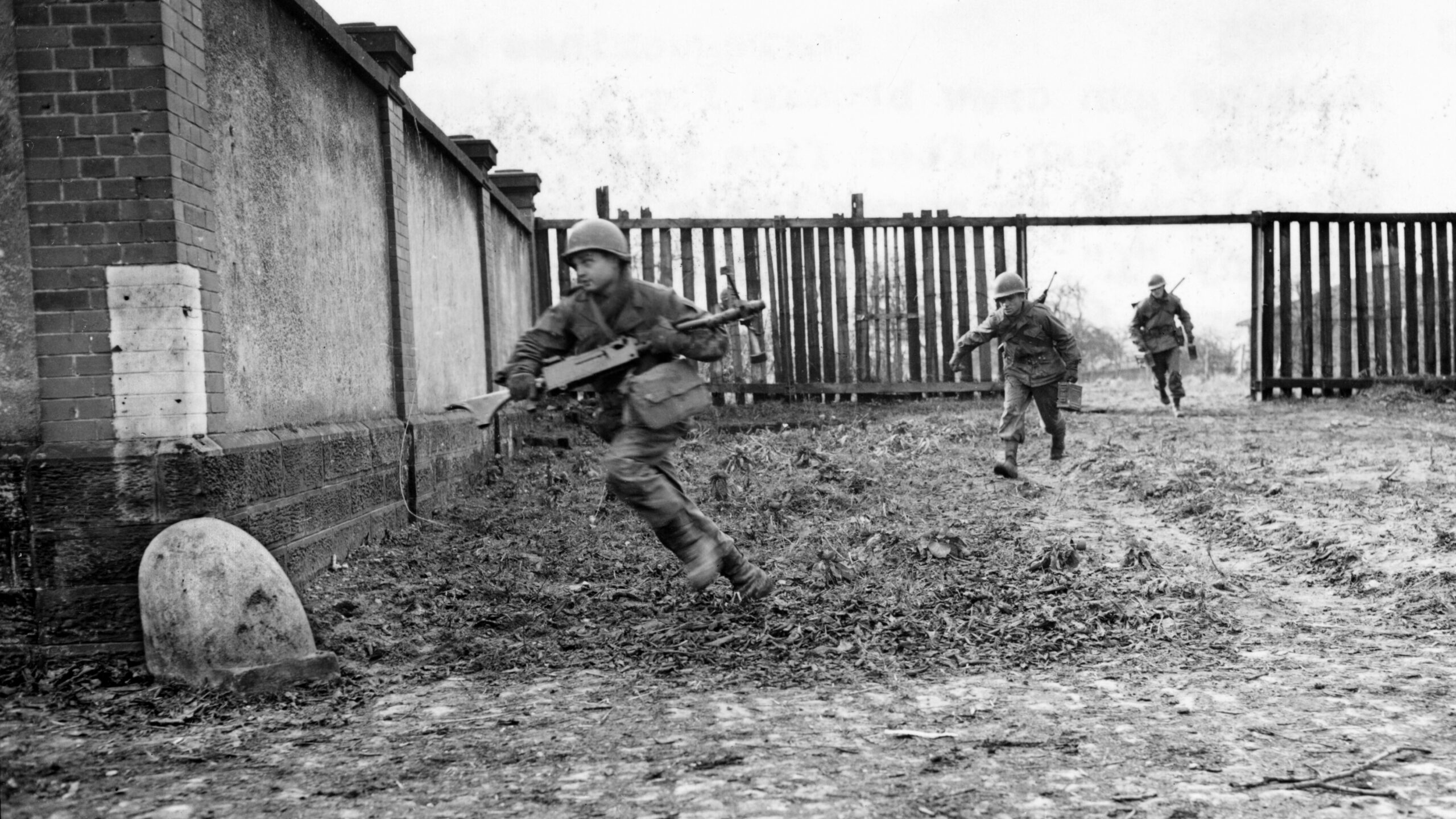
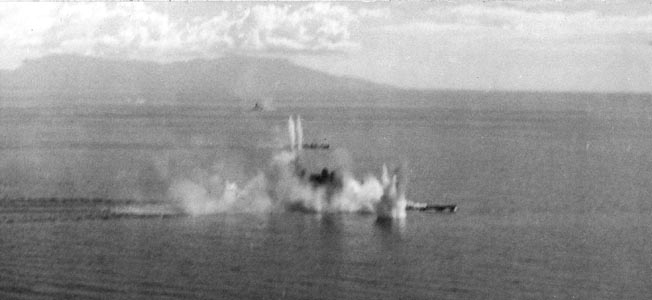
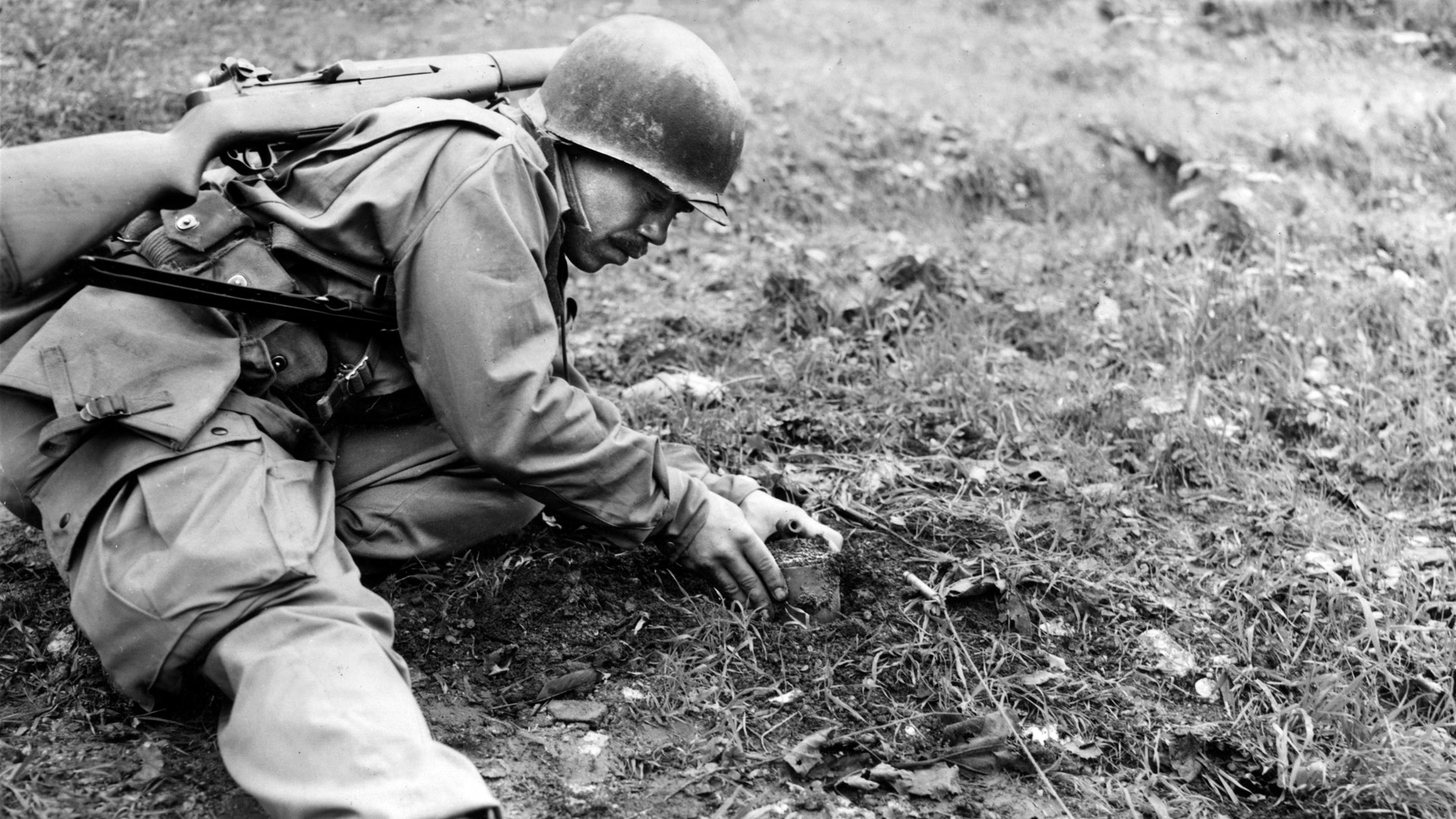
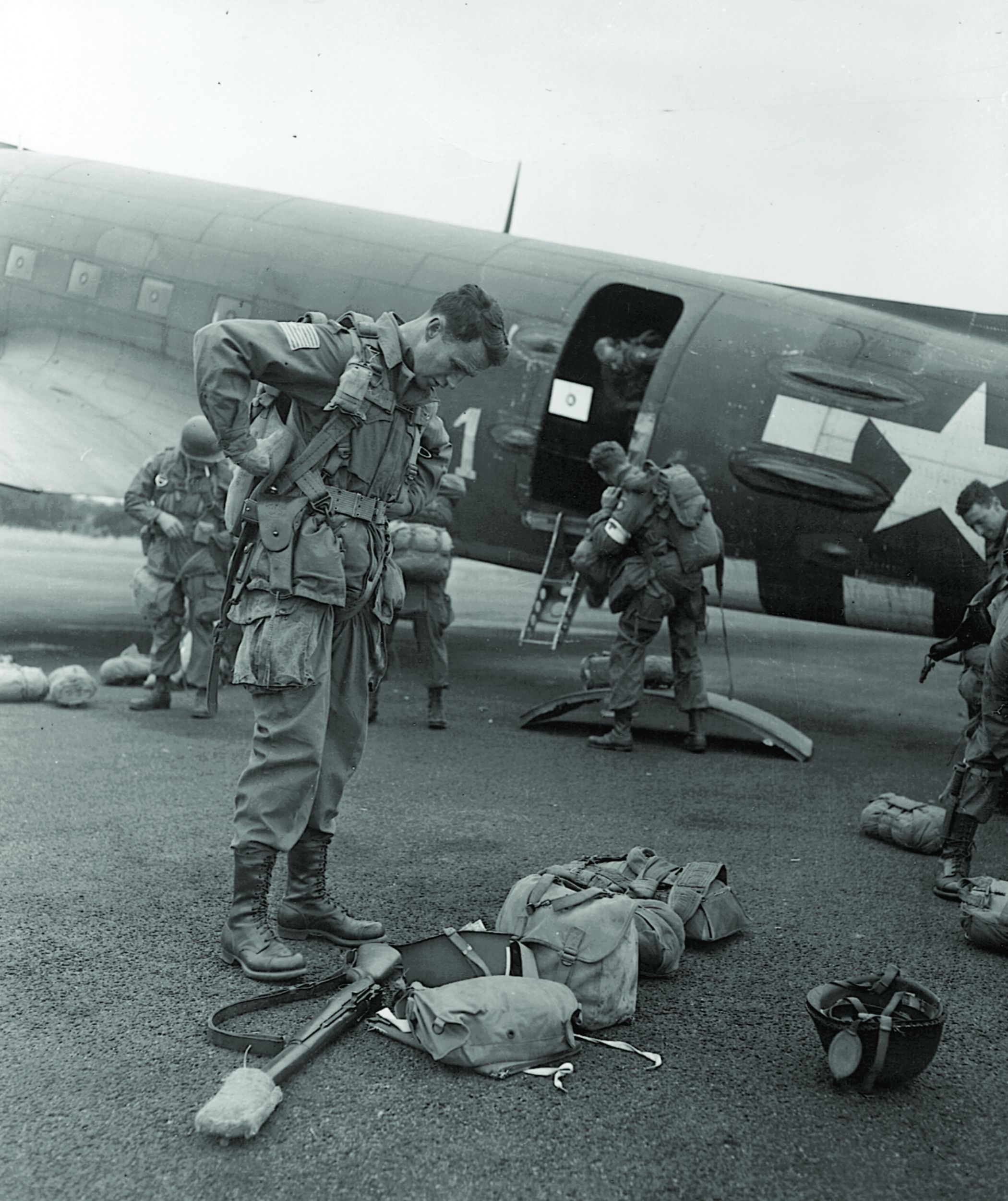
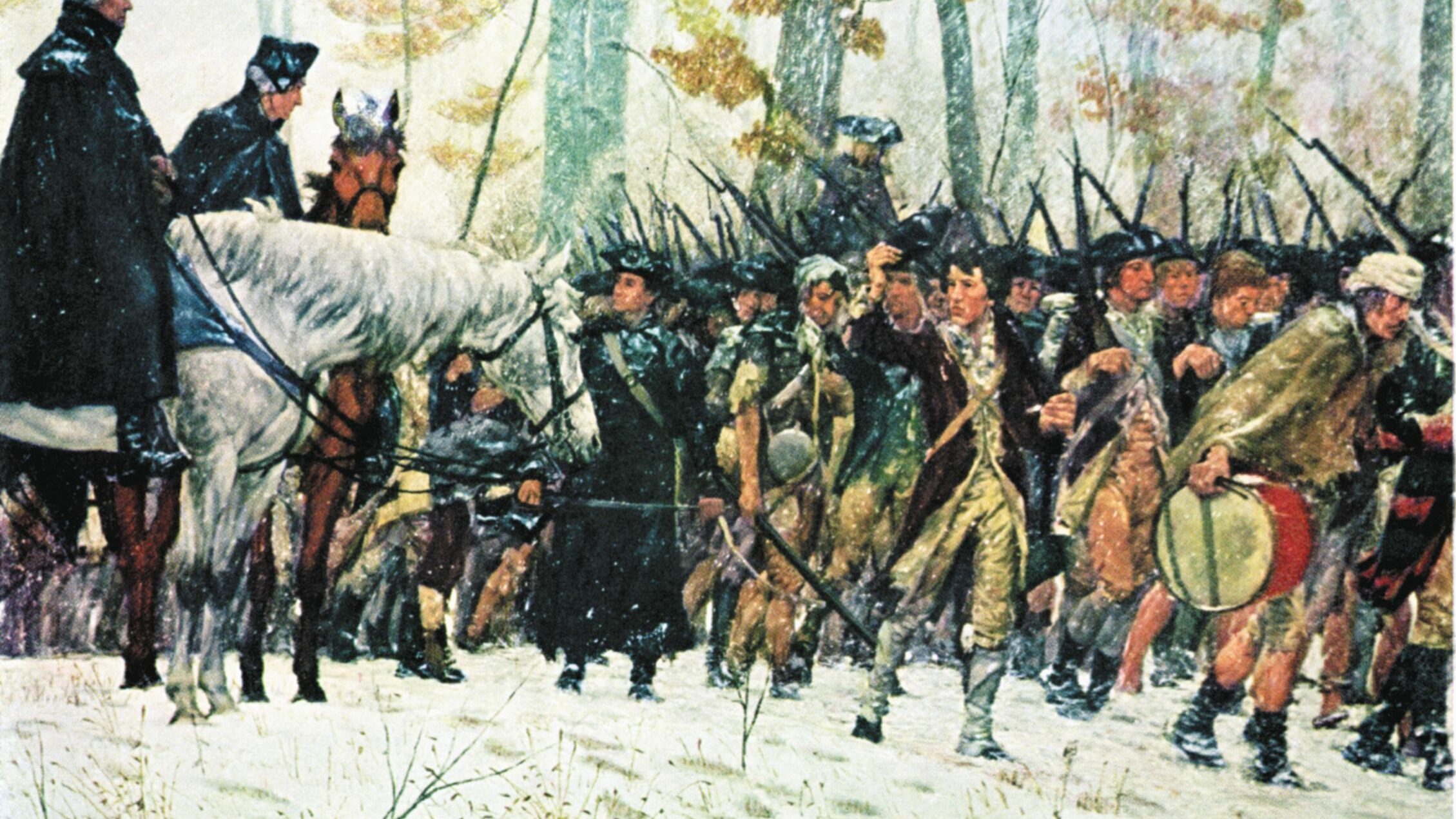
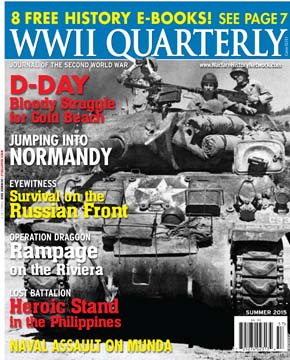

Join The Conversation
Comments
View All Comments